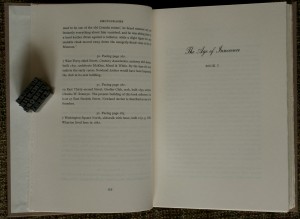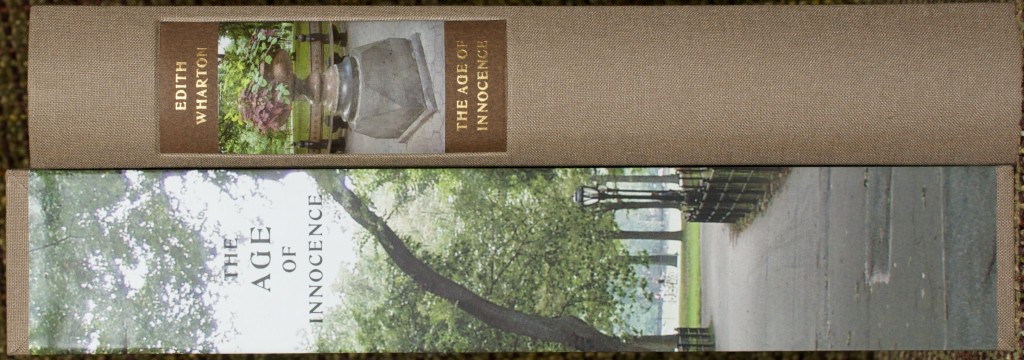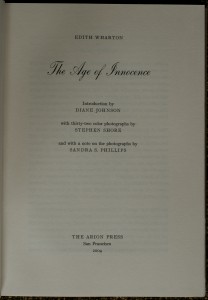
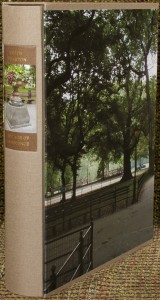 The Age of Innocence seems an appropriate title to begin my first fine press review by a women writer in almost two years. Since I reviewed Rachel Carson’s Undersea published by the Nawakum Press, I’ve reviewed fifteen other books by male writers. Until I researched and wrote my last post about women writers in fine press, I didn’t even think about my innocent neglect because I hadn’t really thought about the fact that I had very few options in my library to review here. So much for my age of innocence.
The Age of Innocence seems an appropriate title to begin my first fine press review by a women writer in almost two years. Since I reviewed Rachel Carson’s Undersea published by the Nawakum Press, I’ve reviewed fifteen other books by male writers. Until I researched and wrote my last post about women writers in fine press, I didn’t even think about my innocent neglect because I hadn’t really thought about the fact that I had very few options in my library to review here. So much for my age of innocence.
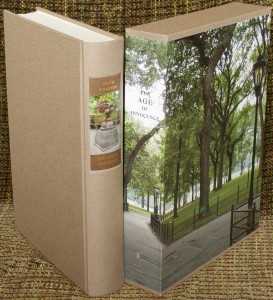 Be that as it may, Edith Wharton has been treated better than almost any other woman besides Jane Austen by the fine presses over the years. In addition to the 2004 Arion Press edition of The Age of Innocence I am reviewing here, this work by Wharton was published by the Limited Editions Club thirty years earlier. That the LEC published this most popular book of Wharton’s is not surprising. I mention it here mainly because this particular Arion Press edition reminds me of many of the LEC books with their classic, simple, and clean designs.
Be that as it may, Edith Wharton has been treated better than almost any other woman besides Jane Austen by the fine presses over the years. In addition to the 2004 Arion Press edition of The Age of Innocence I am reviewing here, this work by Wharton was published by the Limited Editions Club thirty years earlier. That the LEC published this most popular book of Wharton’s is not surprising. I mention it here mainly because this particular Arion Press edition reminds me of many of the LEC books with their classic, simple, and clean designs.
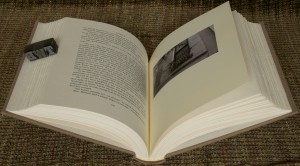 The design starts with a simple and elegant full cloth binding whose color is reminiscent of the brownstone houses lived in by many of the characters that inhabit the novel. The spine label is superb with gold stamped lettering and a small photograph of an urn. The spine is classically rounded with the textblock of all cotton mouldmade Velata paper from Italy’s Magnani mill mimicking the rounded spine on the fore-edge. The paper smells marvelous every time the book is opened. The Potlatch Vintage paper was chosen to highlight Stephen Shore’s photographs while matching the tone of the Velata. Another nice touch.
The design starts with a simple and elegant full cloth binding whose color is reminiscent of the brownstone houses lived in by many of the characters that inhabit the novel. The spine label is superb with gold stamped lettering and a small photograph of an urn. The spine is classically rounded with the textblock of all cotton mouldmade Velata paper from Italy’s Magnani mill mimicking the rounded spine on the fore-edge. The paper smells marvelous every time the book is opened. The Potlatch Vintage paper was chosen to highlight Stephen Shore’s photographs while matching the tone of the Velata. Another nice touch.
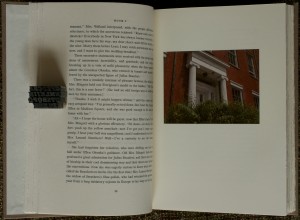 While photographs are not usually my favorite medium for book illustration, in this case I feel that Stephen Shore has captured the feel of Wharton’s New York quite remarkably. And I really like the striking photograph of central park that wraps around the slipcase for the book. I’m a big fan of slipcases for functional reasons and it is nice when some design thought is also put into the slipcase, making it an integral part
While photographs are not usually my favorite medium for book illustration, in this case I feel that Stephen Shore has captured the feel of Wharton’s New York quite remarkably. And I really like the striking photograph of central park that wraps around the slipcase for the book. I’m a big fan of slipcases for functional reasons and it is nice when some design thought is also put into the slipcase, making it an integral part 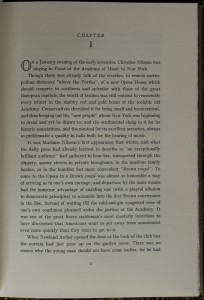 of the overall presentation. I did find it amusing, however, that one of Shore’s photographs contains windows with a couple of air-conditioning units. I’m not sure that the pediment in the picture was beautiful enough to justify a picture that ruins the period feel of the photograph.
of the overall presentation. I did find it amusing, however, that one of Shore’s photographs contains windows with a couple of air-conditioning units. I’m not sure that the pediment in the picture was beautiful enough to justify a picture that ruins the period feel of the photograph.
The page design and type choices add to the elegance of the book. The Typo Script on the title page is a nice touch along with the DeVinne Outline for the initial letters of each chapter. But for me, it is the Ronaldson used for the text that adds that extra touch. I’m not sure I’ve seen that type before but it works exquisitely here.
Edith Wharton was a remarkable woman in many ways. Although she came from the New York society so vividly portrayed in The Age of Innocence and other books like The House of Mirth, she was very independent. She 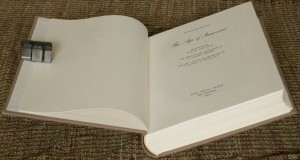 believed women should be educated and elevated herself above the standards of education typically applied to women of her time and societal standing. She was obviously very autodidactic in that way, as she had to find a way around the barriers put up around the classic female education. She was a gifted interior and garden designer, and traveled extensively. World War I broke out while she was in France and she became very involved in supporting the war effort and helping refugees. Despite being a foreigner, she managed to get close enough to the front to write several articles for Scribner’s Magazine that were later published in a popular book entitled Fighting France: From Dunkerque to Belfort. I inherited this book years ago from one of my grandmothers and didn’t realize it was written by “the” Edith Wharton. I’ve moved it up in the “to be read” queue as a result. The Age of Innocence won the
believed women should be educated and elevated herself above the standards of education typically applied to women of her time and societal standing. She was obviously very autodidactic in that way, as she had to find a way around the barriers put up around the classic female education. She was a gifted interior and garden designer, and traveled extensively. World War I broke out while she was in France and she became very involved in supporting the war effort and helping refugees. Despite being a foreigner, she managed to get close enough to the front to write several articles for Scribner’s Magazine that were later published in a popular book entitled Fighting France: From Dunkerque to Belfort. I inherited this book years ago from one of my grandmothers and didn’t realize it was written by “the” Edith Wharton. I’ve moved it up in the “to be read” queue as a result. The Age of Innocence won the 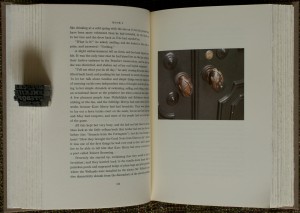 Pulitzer Prize for Fiction in 1921, albeit at the expense of Wharton’s friend Sinclair Lewis, whose Main Street was the first choice of all the fiction judges. The judges were overruled by the conservative board for the prize. Nevertheless, she was the first woman to win the prestigious prize. It makes me wonder if her novel was really read by the those who had the final say. I would be interested to see who would win if the Daphne Award was done for 1921.
Pulitzer Prize for Fiction in 1921, albeit at the expense of Wharton’s friend Sinclair Lewis, whose Main Street was the first choice of all the fiction judges. The judges were overruled by the conservative board for the prize. Nevertheless, she was the first woman to win the prestigious prize. It makes me wonder if her novel was really read by the those who had the final say. I would be interested to see who would win if the Daphne Award was done for 1921.
All of this is to say that Wharton is much closer to Countess Oleska than May Welland, the two main female characters in the book. May Welland can be summed up by a couple of passages where her fiancé and the book’s protagonist, Newland Archer, is contemplating women in general and her in particular:
That terrifying product of the social system he belonged to and believed in, the young girl who knew nothing and expected everything, looked back at him like a stranger through May Welland’s familiar features; and once more it was borne in on him that marriage was not the safe anchorage he had been taught to think, but a voyage on uncharted seas.
And, in another passage,
And he felt himself oppressed by this creation of factitious purity, so cunningly manufactured by a conspiracy of mothers and aunts and grandmothers and long-dead ancestresses, because it was supposed to be what he wanted, what he had a right to, in order that he might exercise his lordly pleasure in smashing it like an image made of snow.
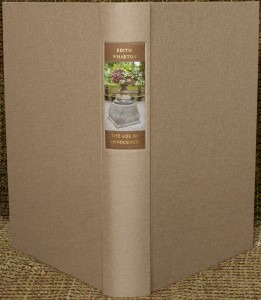 Archer is also a product of his social system, trapped as well, but with much more room to push against the boundaries than women. Early in the book, he is contemplating the Countess after seeing her at the opera:
Archer is also a product of his social system, trapped as well, but with much more room to push against the boundaries than women. Early in the book, he is contemplating the Countess after seeing her at the opera:
The case of the Countess Olenska had stirred up old settled convictions and set them drifting dangerously through his mind. His own exclamation: “Women should be free–as free as we are,” struck to the root of a problem that it was agreed in his world to regard as non-existent. “Nice” women, however wronged, would never claim the kind of freedom he meant, and generous-minded men like himself were therefore–in the heat of argument–the more chivalrously ready to concede it to them. Such verbal generosities were in fact only a humbugging disguise of the inexorable conventions that tied things together and bound people down to the old pattern.
Another passage that gets to the heart of the dichotomy between men and women occurs later in the book as he muses about an affair of his younger days before becoming affianced to May:
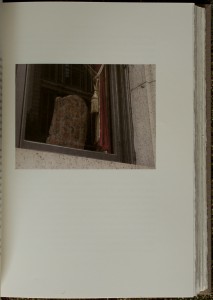 The affair, in short, had been of the kind that most of the young men of his age had been through, and emerged from with calm consciences and an undisturbed belief in the abysmal distinction between the women one loved and respected and those one enjoyed–and pitied. In this view they were sedulously abetted by their mothers, aunts, and other elderly female relatives, who all shared Mrs. Archer’s belief that when “such things happened” it was undoubtedly foolish of the man, but somehow always criminal of the woman.
The affair, in short, had been of the kind that most of the young men of his age had been through, and emerged from with calm consciences and an undisturbed belief in the abysmal distinction between the women one loved and respected and those one enjoyed–and pitied. In this view they were sedulously abetted by their mothers, aunts, and other elderly female relatives, who all shared Mrs. Archer’s belief that when “such things happened” it was undoubtedly foolish of the man, but somehow always criminal of the woman.
The Age of Innocence treats a mostly vanished time and the city of New York in much the same way that James Joyce treated Dublin. Immortalizing the city of her time and making it as much a character in the book as the people. That’s one reason that Shore’s photography of those places works so well for this particular book. In her insightful introduction, Diane Johnson, writes of the book that “The Age of Innocence, loving in its depiction of New York as a physical entity…is severe on the mores of New York society.” Johnson continues to develop the ties Wharton uses between places and those mores, stating that
Throughout the novel, her observations of building and decorations as the emblems of the spiritual and intellectual condition of the characters or the community form an essential part of the narrative.
Along with the contrasts between innocence and experience, and between conventionality and originality, the underlying and central opposition of the novel is that of Europe and America, in the minds of Wharton’s New Yorkers, “the Siren Isle” compared to “the haven of blameless domesticity”. It is a subject sill timely and perplexing today. The attitudes Wharton portrayed as unattractive in her countrymen she might still find to deplore–preoccupation with money, indifference or even hostility to culture, puritanism. Wharton, writing The Age of Innocence in 1920 from her vantage point as a permanent resident of Europe, prefers the Siren Isle, the realm of art and love.
 Indeed. I also prefer the realm of art and love even as I remain a rebellious resident of this “haven of blameless domesticity.” And I prefer the brave Countess Oleska to the other characters in the book, having closed it after reading the last lines with a severe distaste for Newland Archer. Her confession in one of the penultimate scenes between Archer and her showed her strength as well as displaying Wharton’s prose at the height of her powers:
Indeed. I also prefer the realm of art and love even as I remain a rebellious resident of this “haven of blameless domesticity.” And I prefer the brave Countess Oleska to the other characters in the book, having closed it after reading the last lines with a severe distaste for Newland Archer. Her confession in one of the penultimate scenes between Archer and her showed her strength as well as displaying Wharton’s prose at the height of her powers:
It was impossible to make the confession more dispassionately, or in a tone less encouraging to the vanity of the person addressed. Archer reddened to the temples, but dared not move or speak: it was as if her words had been some rare butterfly that the least motion might drive off on startled wings, but that might gather a flock about it if it were left undisturbed.
Edith Wharton well deserves of her accolades as a writer and definitely deserving of her inclusion into the “club” of fine press editions. Arion Press has definitely done her justice here and I hope to someday see how the Limited Editions Club treated her.
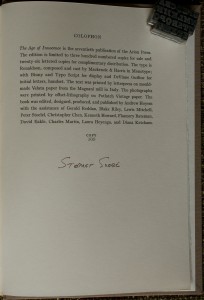
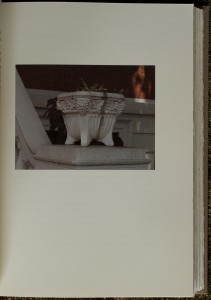 AVAILABILITY: I believe the Arion Press edition sold out in 2012. (My book is Copy 300 of 300, and was purchased in December that year). Information is still available on the Arion Press website here and occasionally a copy will become available there. It is also occasionally available on the rare books market.
AVAILABILITY: I believe the Arion Press edition sold out in 2012. (My book is Copy 300 of 300, and was purchased in December that year). Information is still available on the Arion Press website here and occasionally a copy will become available there. It is also occasionally available on the rare books market.

